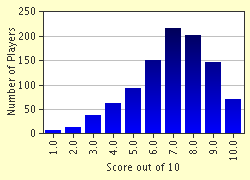Quiz Answer Key and Fun Facts
1. You are interested in doing an experiment on bacteria. You notice that bacteria tend to grow on agar gel. Every time you look at a dish of agar, you see bacterial colonies. What do you call this step of the scientific method?
2. Hmmm. After looking at lots of dishes of agar and finding bacteria on every one, you say to yourself, 'Barring other factors, bacteria will grow on an uncovered dish of agar at room temperature.' What, in layman's but not scientific terms, have you just created?
3. You have read research that claims that garlic juice kills bacteria. You decide to do an experiment to see if garlic juice will prevent bacteria from growing on agar gel. You state, 'I think bacteria will not grow on agar gel that has been treated with garlic juice.' This statement is a...
4. You set up your experiment. You need to think about things like the amount of gel in each dish, the amount of garlic juice you use, etc. You know that you want to use the same amount of each of these items for each dish in your experiment. These things are called...
5. You will set up two groups of Petri dishes. Both groups will get equal amounts of agar gel. Both groups will use dishes of the same size, and the dishes will be held at the same temperature. Both groups will be inoculated with the same amount and strain of bacteria. One group will have 5 ml. of garlic extract added to each dish. The group that does NOT have garlic extract added is the...
6. You will set up two groups of Petri dishes. Both groups will get equal amounts of agar gel. Both groups will use dishes of the same size, and the dishes will be held at the same temperature. Both groups will be inoculated with the same amount and strain of bacteria. One group will have 5 ml. of garlic extract added to each dish. The addition of garlic extract is the...
7. You will set up two groups of Petri dishes. Both groups will get equal amounts of agar gel. Both groups will use dishes of the same size, and the dishes will be held at the same temperature. Both groups will be inoculated with the same amount and strain of bacteria. One group will have 5 ml. of garlic extract added to each dish. Seven days after you add the bacteria, you measure the amount of bacterial growth in each of your dishes. This growth is the...
8. You used a total of 32 dishes in your experiment, measuring the amount of bacterial growth in each dish by noting the square centimeters of the area that was covered by growth on day 7. Since this is a new experiment, we don't have any standard deviation figures from other, similar experiments. Which statistical test would be most appropriate to determine whether or not there is a significant difference between the two groups?
9. In order to show that your results are indeed significant, you must disprove the null hypothesis. What is the null hypothesis?
10. OK, it looks like your garlic extract kills bacteria! Have you proved that garlic extract kills bacteria?
Source: Author
crisw
This quiz was reviewed by FunTrivia editor
WesleyCrusher before going online.
Any errors found in FunTrivia content are routinely corrected through our feedback system.


